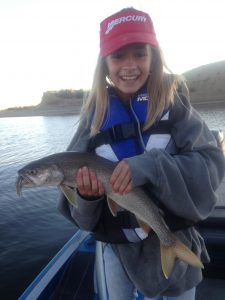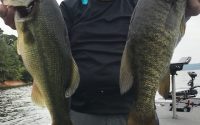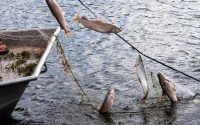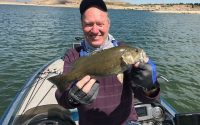Lake Trout – Too Many Mouths To Feed

For many anglers, lake trout (mackinaw) is a “bucket list” species that can only be caught in their dreams. Not that they are particularly difficult to catch, but they are not found in all trout waters and so they must be “targeted.” Since they are not found universally, anglers must learn where they live, how to catch them, and then commit to take as many trips as necessary to break through the “learning barrier” and catch their first fish.
Once the first fish is in the boat, or on the ice, the next goal is generally to catch a trophy, a 20, 30 or 40 pound giant. Some anglers spend much of their adult “fishing” lives pursuing these huge fish, a worthy quest, indeed.
Too Many Lake Trout in Flaming Gorge
At Flaming Gorge Reservoir, one of the finest lake trout fisheries in the world, a long-term study conducted by the Utah Division of Wildlife Resources (UDWR) and the Wyoming Game and Fish Department, shows there are too many small lake trout (under 28 inches in length) in the reservoir which has the potential to damage or eventually destroy the ability of anglers to target and catch a trophy fish.
Ryan Mosely, the lead fisheries biologist at Flaming Gorge for the UDWR, in a recent news release, is convinced that there are literally too many mouths to feed for the food available, and that the trend for overpopulation of smaller lake trout has the potential to threaten the fishery. “Growth rates for lake trout,” says Mosley, “have diminished since the 1990s. In the 1990s, an eight-year-old lake trout was about 30 inches long. Today, an eight-year-old is about 23 inches long.”
“In addition,” continues Mosely, “the number of lake trout in the reservoir has increased 89 percent in just the last couple of years. And, we are concerned the situation is going to get worse.”
Not Enough Food
The small lake trout are actively competing for food with other popular species in the reservoir such as kokanee salmon and rainbow trout. Not having enough food to go around is the primary contributor to the growth rate decline over the past 20 years. And, of course, in a domino effect, kokanee salmon and rainbow growth rates are also in decline.
There is, however, a silver lining, if anglers buy into the solution.
The Solution: Keep More Fish!
Wyoming and Utah officials, including Mosely, believe if anglers were to keep more fish under 28 inches in length, the fishery would improve, and all the species in the reservoir would benefit. Since 2006, the lake trout limit has been increased to eight fish per day with only one of those fish over 28 inches in le1ngth.
“And, unbeknownst to many anglers, continues Mosely, “the smaller lake trout are quite tasty. They’re one of my favorite fish to eat. Only kokanee salmon rival them in taste.”
Having fished for lake trout for a little more than a decade, I too can attest to their qualities as table fare. Some believe them to be “oily” and because they have pale, colorless filets, they don’t compete with other trout species. I find that hard to believe. As I have written even earlier this year, “lake trout on the half shell” is one of my family’s favorite meals. If you don’t believe me just ask my grandchildren.
So, when are you going to get out to Flaming Gorge and take lake trout off your bucket list or continue your search for a real giant?
Within a month, there will be safe ice on parts of Flaming Gorge. Four to six inch tube jigs tipped with night crawlers or sucker meat are very effective lures through the ice. With a good fish finder, some warm clothes, an ice auger, and a few good friends to share the adventure, this winter may be your time to catch your first lake trout, a true trophy, or just fill your freezer with great-tasting fish that are easy to target and catch.










